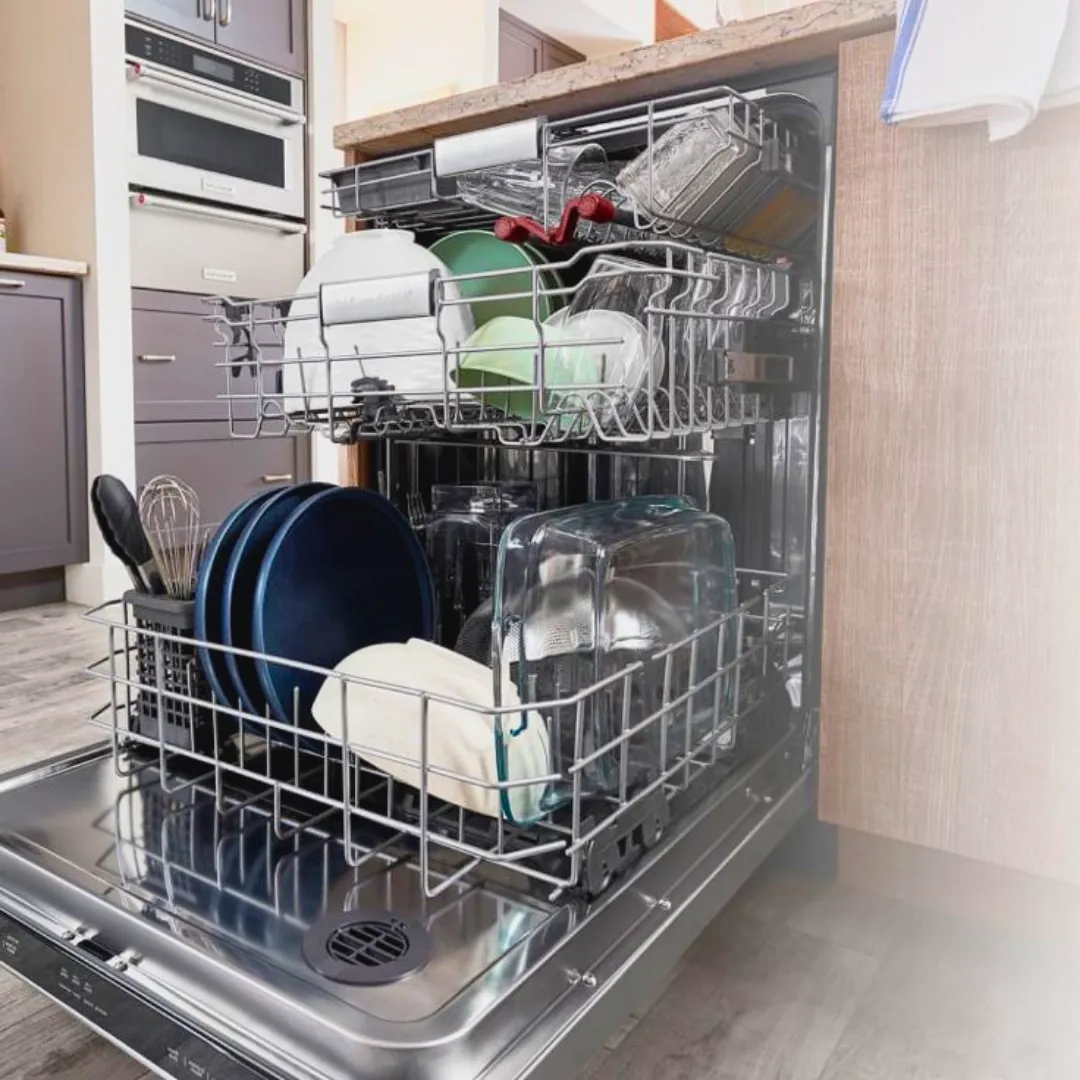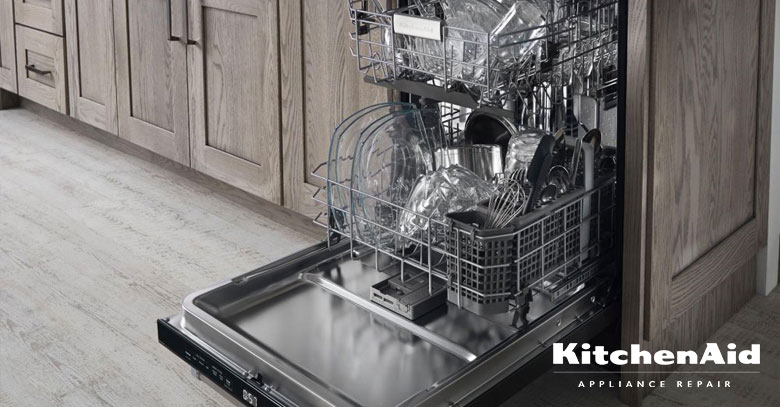To troubleshoot a Kitchen Aid dishwasher, start by checking the power source and water supply. Then, ensure the dishwasher’s door is properly closed and inspect the dishwasher for any debris or clogs in the filter or spray arms.
If the issue persists, consult the user manual or contact the manufacturer for further assistance. Having a Kitchen Aid dishwasher malfunction can be a frustrating experience, but troubleshooting the appliance can often resolve the problem without the need for professional repair.
By following a few simple steps, you can identify and resolve common issues that may arise with your dishwasher. We’ll explore some straightforward troubleshooting tips to help you address any problems you may encounter with your Kitchen Aid dishwasher. Whether it’s an issue with power supply or drainage, we’ll guide you through the process to get your dishwasher back up and running smoothly.
Common Issues With Kitchen Aid Dishwashers
Is your Kitchen Aid dishwasher not starting? This can be a frustrating problem, but don’t worry, there are a few things you can check to troubleshoot the issue. Firstly, ensure that the dishwasher is properly plugged in and that the circuit breaker hasn’t tripped. Secondly, check if the door latch is securely closed. If it’s not, the dishwasher may not start. Additionally, if your dishwasher is leaking water, check for any loose or damaged hoses and tighten or replace them as needed. Finally, if you’re finding that your dishes aren’t getting clean, make sure you’re loading them correctly and using the right amount of detergent. Also, check the spray arms for any clogs or obstructions. Following these troubleshooting steps should help you resolve these common Kitchen Aid dishwasher issues.
If your Kitchen Aid dishwasher is not starting, there are a few potential causes. Ensure that the dishwasher is properly plugged in and that the circuit breaker is not tripped. Check if the door latch is securely closed, as an open latch can prevent the dishwasher from starting. If these basic checks don’t solve the issue, you may need to consult the user manual or contact a professional for further assistance.
Leaking water from your Kitchen Aid dishwasher can be a sign of various problems. Start by inspecting the hoses for any signs of damage or loosening, and tighten or replace them as necessary. Check the door gasket for any cracks or gaps and replace it if needed. Additionally, make sure the dishwasher is properly leveled to prevent water leakage. It’s also a good idea to examine the spray arms for any clogs or blockages that could disrupt the water flow. If the issue persists, consider seeking professional help.
If your dishes aren’t getting clean in your Kitchen Aid dishwasher, there are a few potential causes to consider. Ensure that you’re loading the dishes properly, allowing enough space for water and detergent to circulate. Check the spray arms for any clogs or obstructions that could hinder their effectiveness. Additionally, make sure you’re using the correct amount of detergent for your dishwasher and adjusting the settings accordingly. If the problem continues, you may need to clean the dishwasher filter or consult the user manual for further troubleshooting steps.

Credit: kitchenaid-appliance-repair-professionals.com
Steps To Troubleshoot Kitchen Aid Dishwashers
Check Power Supply: Ensure that the dishwasher is properly plugged in and the power is turned on. Check the circuit breaker and power source to rule out any electrical issues.
Inspect for Leakage: Examine the dishwasher for any signs of leakage, especially around the door and the bottom of the appliance. Address any leaks immediately to prevent further damage.
Clean Filters and Spray Arms: Remove and clean the filters and spray arms to ensure that water can flow freely through the dishwasher. Clogs in these areas can lead to inefficient cleaning.
Advanced Troubleshooting Techniques
Testing the Door Switch: Start by unplugging the dishwasher. Remove the inner door panel and locate the door switch. Use a multimeter to test for continuity. If the switch does not show continuity, it may need to be replaced.
Examining the Drain Pump: After disconnecting power, remove the lower spray arm and the pump cover to access the drain pump. Check for any clogs or debris obstructing the pump. Also, ensure that the pump motor is running properly.
Calibrating the Dishwasher: To calibrate the dishwasher, press the keys in the following sequence: Hi Temp Scrub, Energy Saver Dry, Hi Temp Scrub, Energy Saver Dry. Once pressed, the dishwasher will enter calibration mode, and a series of beeps will confirm it’s complete.
When To Seek Professional Help
If your Kitchen Aid dishwasher is experiencing persistent error codes, it may be time to seek professional help. These error codes can indicate underlying issues that require the expertise of a technician. Additionally, unusual noises coming from your dishwasher could be a sign of a problem. These noises may indicate electrical or mechanical issues that need to be addressed. It is important to take these signs seriously and seek assistance to prevent further damage to your dishwasher. Professional technicians have the knowledge and experience to diagnose and fix these issues quickly and efficiently. By reaching out for professional help, you can ensure that your Kitchen Aid dishwasher is back up and running at optimal performance.
Maintenance Tips To Prevent Future Problems
Discover essential maintenance tips to prevent potential issues with your Kitchen Aid dishwasher. Troubleshoot efficiently to ensure seamless functionality and prolong the lifespan of your appliance. Stay proactive in maintaining your dishwasher for optimal performance and longevity.
| Maintenance Tips to Prevent Future Problems |
|---|
| Regularly clean the dishwasher and filters to ensure optimal performance. Use high-quality detergent for effective cleaning results. Properly load dishes to avoid blockages and ensure even cleaning. |

Credit: m.youtube.com

Credit: nashfix.us
Frequently Asked Questions On How To Troubleshoot Kitchen Aid Dishwasher
How Do I Run Diagnostics On My Kitchenaid Dishwasher?
To run diagnostics on your KitchenAid dishwasher, follow these steps: 1. Press the “Hi Temp Scrub” and “Energy Saver Dry” buttons on the control panel. 2. Wait for the diagnostic test to start, indicated by the lights flashing. 3. The dishwasher will go through various cycles to check for any issues.
4. Once the diagnostics are complete, the dishwasher will display error codes if any problems are detected. 5. Refer to the user manual or contact customer support to interpret the error codes and resolve the issue.
What Is The Most Common Problem With A Kitchenaid Dishwasher?
The most common problem with a KitchenAid dishwasher is a clogged spray arm. This issue can result in dishes not being cleaned properly. Regular cleaning and proper maintenance can help prevent this problem.
How Can I Reset My Kitchenaid Dishwasher?
To reset your KitchenAid dishwasher, press “Start/Resume” and close the door within 3 seconds. Then select the desired cycle and press “Start/Resume” again.
What Would Cause A Kitchenaid Dishwasher Not To Start?
Possible causes for a KitchenAid dishwasher not starting could include a faulty door switch, malfunctioning control panel, or a blown fuse. Ensure the door is securely closed, check for any error codes, and try resetting the dishwasher. If the issue persists, it may require professional assistance.
Conclusion
To sum up, troubleshooting your KitchenAid dishwasher doesn’t have to be a daunting task. By following the steps outlined in this blog post, you can easily identify and fix common issues that may arise. From checking the power supply to examining the inlet valve and filters, taking these simple yet effective measures can help restore your dishwasher’s functionality and save you from unnecessary expenses.
Remember to regularly maintain and clean your dishwasher to prevent future problems. Happy troubleshooting! (47 words)

